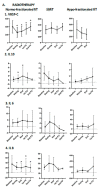Changes in Blood Biomarkers of Angiogenesis and Immune Modulation after Radiation Therapy and Their Association with Outcomes in Thoracic Malignancies
- PMID: 34830880
- PMCID: PMC8616228
- DOI: 10.3390/cancers13225725
Changes in Blood Biomarkers of Angiogenesis and Immune Modulation after Radiation Therapy and Their Association with Outcomes in Thoracic Malignancies
Abstract
The effects of radiotherapy on systemic immunity remain to be fully characterized in a disease-specific manner. The aim of the study was to examine potential biomarkers of systemic immunomodulation when using radiotherapy for thoracic malignancies. Serial blood samples were collected from 56 patients with thoracic malignancies prior (RTbaseline), during (RTduring) and at the end of radiotherapy (RTend), as well as at the first (FU1) and second follow-up (FU2). The changes in serum levels of IL-10, IFN-γ, IL-12p70, IL-13, IL-1β, IL-4, IL-6, IL-8, TNF-α, bFGF, sFlt-1, PlGF, VEGF, VEGF-C, VEGF-D and HGF were measured by multiplexed array and tested for associations with clinical outcomes. We observed an increase in the levels of IL-10, IFN-γ, PlGF and VEGF-D and a decrease in those of IL-8, VEGF, VEGF-C and sFlt-1 during and at the end of radiotherapy. Furthermore, baseline concentration of TNF-α significantly correlated with OS. IL-6 level at RTend and FU1,2 correlated with OS (RTend: p = 0.039, HR: 1.041, 95% CI: 1.002-1.082, FU1: p = 0.001, HR: 1.139, 95% CI: 1.056-1.228, FU2: p = 0.017, HR: 1.101 95% CI: 1.018-1.192), while IL-8 level correlated with OS at RTduring and RTend (RTduring: p = 0.017, HR: 1.014, 95% CI: 1.002-1.026, RTend: p = 0.004, HR: 1.007, 95% CI: 1.061-1.686). In conclusion, serum levels of TNF-α, IL-6 and IL-8 are potential biomarkers of response to radiotherapy. Given the recent implementation of immunotherapy in lung and esophageal cancer, these putative blood biomarkers should be further validated and evaluated in the combination or sequential therapy setting.
Keywords: esophageal cancer; immune modulation; lung cancer; radiotherapy.
Conflict of interest statement
D.G.D. received consultant fees from Bayer, BMS, Simcere, Sophia Biosciences, Innocoll and Surface Oncology and research grants from Bayer, Merrimack, Exelixis, BMS and Surface Oncology. No reagents or funding from these companies was used in this study.
Figures





References
Grants and funding
LinkOut - more resources
Full Text Sources

